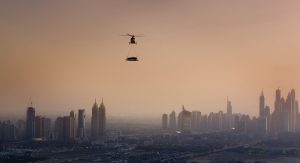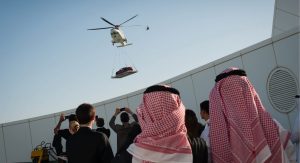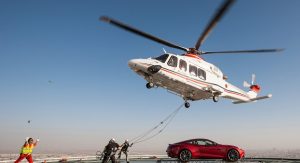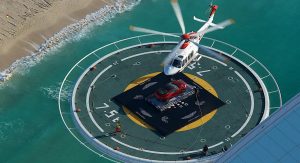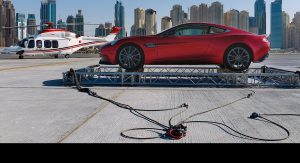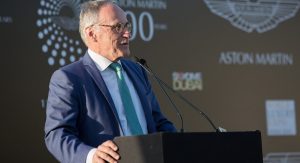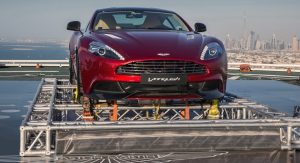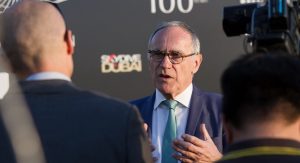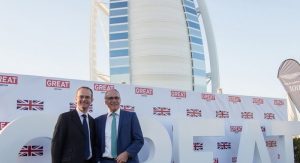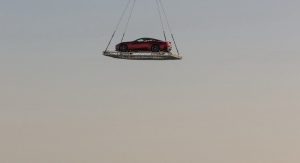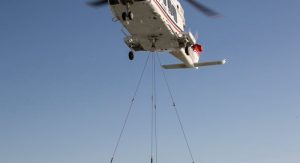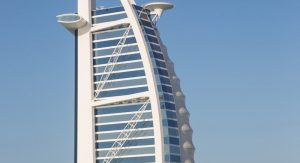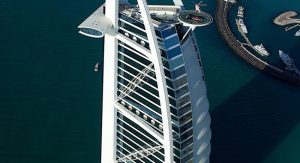Transferring vehicles in the air by helicopter for promotional purposes is nothing new in the world of exotic luxury and sports car brands, as we’ve seen it being done many times in the past (see how Lamborghini, Ferrari and Bentley did it by clicking the respective links).
Nevertheless, Aston Martin can lay claim to being the first to place a car onto the helipad of the world famous ‘Burj Al Arab’ hotel in Dubai, which sits 1,000ft above the ground at the top of the sail-shaped building, as part of its ongoing celebrations for its 100th birthday.
The car Aston Martin landed on the helipad is the brand’s current flagship coupe, the new 2013 Vanquish.
Speaking from the top of the hotel, Aston Martin CEO Dr Ulrich Bez said:
“It is with great pride that we continue our centenary celebrations in such unique manner in the city of Dubai. Today we are achieving another world first – one of many for Aston Martin over the years. This is a true feat for Aston Martin and a fantastic way to begin a new century of global success for our iconic brand.”
Head past the break to watch the video and if you wish, take a look at two lists released by Aston Martin, one informing us about 10 things we may or may not about the company, and the other highlighting some of its historic moments in the last 100 years.
VIDEO

PHOTO GALLERY

From Aston Martin:
10 things you didn’t know about Aston Martin:
- There have been 10 different versions of the iconic Aston Martin badge. The current version was introduced in 2003
- The Aston Martin wings badge has its origins in ancient Egypt – derived from the open wings of the scarab beetle
- In 100 years Aston Martin has produced just over 60,000 sports cars
- It is accurately estimated that more than 90% of all Aston Martins built are still in existence
- Aston Martin has manufactured cars from seven locations in the past 100 years
- Aston Martin’s global HQ at Gaydon, the company’s first purpose-built home, celebrates its tenth anniversary in 2013
- The Aston Martin Owners Club was founded in 1935 at The Grafton Hotel, London
- The now sold-out One-77 hypercar is Aston Martin’s most exclusive, powerful and expensive production model to date
- It took 2,700 man hours to produce each One-77
- The painting process for the current Aston Martin range takes between 50 and 70 hours per car
Aston Martin timeline
1913 On 15 January 1913 Robert Bamford and Lionel Martin form Bamford and Martin Ltd, based in Henniker Mews, off the Fulham Road in London
1915 The first Aston Martin is registered on 16 March. It is christened ‘Coal Scuttle’ and powered by a 1389cc Coventry Climax engine
1920 The second prototype Aston Martin is developed at new premises at Abingdon Road, Kensington. It’s fitted with a 1487cc engine and front wheel brakes. It is the true forerunner to the first production cars
Count Louis Zborowski begins to invest in the company and Robert Bamford steps away
1922 An Aston Martin prototype nicknamed ‘Bunny’ breaks ten world records in 16 1/2 hours at Brooklands. It averages 76mph Aston Martin fields two cars at the French Grand Prix on 16 July
1925 The company goes into receivership but is rescued by Lord Charnwood, John Benson, Augustus Cesare Bertelli and William Renwick. It is renamed Aston Martin Motors and relocates to Feltham, Middlesex
1932 Bertelli proves the speed and endurance of Aston Martin’s new range by winning the Biennial Cup at the Le Mans 24 hour race with Pat Driscol
Sir Arthur Sutherland becomes the new owner of Aston Martin and focuses his efforts on a new road car range
1935 The Aston Martin Owners’ Club is founded at The Grafton Hotel on Tottenham Court Road, London
1939 The highly advanced Atom prototype takes shape. It has an early type of spaceframe chassis, independent front suspension, an aerodynamic shape and a four-speed Cotal electric gearbox
1947 Engineering magnate David Brown answers an ad in The Times seeking an owner for a ‘high class motor business’ and buys Aston Martin for £20,000. Following the purchase of Lagonda he forms Aston Martin Lagonda
1948 A 2-litre Sports wins the Spa-Francorchamps 24-hour race
1949 Three DB2s tackle the Le Mans 24 hours, including one with a new 2.6-litre in-line six-cylinder engine designed by Willie Watson
1955 David Brown buys Tickford Motor Bodies in Newport Pagnell, Buckinghamshire. Production of Aston Martins begins to migrate to the new facility
1958 The DB4 is launched, powered by a new 3.7-litre in-line six cylinder engine designed by Tadek Marek. It produces 240bhp and propels the DB4 to 140mph. The four-seater body is designed by Carrozzeria Touring of Milan, using their ‘Superleggera’ construction method in which handmade aluminium panels are fixed to a tubular frame built onto a substantial platform chassis
1959 The DBR1 wins the World Sports Car Championship with victories in the Nürburgring 1000km and at Goodwood along the way. The crowning glory is outright victory at the Le Mans 24 hour with Carroll Shelby and Roy Salvadori at the wheel
1960 Aston Martin begins its long association with Milan-based coachbuilder Zagato. The DB4 GT Zagato features a 314bhp engine, acrylic windows and a super lightweight body. Only 19 are produced between 1960-1963
1964 Sean Connery as James Bond drives the new DB5 in Goldfinger and an iconic on-screen relationship is born
1972 David Brown sells Aston Martin and Company Developments take control. In a period of uncertainty Aston Martin changes hands again
1975 Canadian George Minden and American businessman Peter Sprague rescue the company from administration
1976 The controversial William Towns’-designed Lagonda is launched. It attracts a huge amount of publicity and sales are strong
1981 The company changes hands again, this time bought by Tim Hearley’s CH Industrial and Victor Gauntlett’s Pace Petroleum. Gauntlett becomes chairman and quickly begins to turn Aston Martin around
1984 Automotive Industrial becomes sole owners of Aston Martin but Gauntlett stays on in his role. He’s soon a shareholder again when shipping magnate Peter Livanos takes a 75% share and Gauntlett the remaining 25%
1986 The Vantage Zagato is launched and becomes one of the fastest supercars in the world with a top speed of 186mph. Just 52 Coupés and 37 Volantes are produced
1987 Ford Motor Company takes a 75% share of Aston Martin and later becomes sole owner. A period of rapid investment begins
1993 The Ian Callum-designed DB7 is unveiled at the Geneva Auto Salon. It goes on sale the following year and is produced at a new factory in Bloxham, Oxfordshire. The DB7 goes on to become the most significant Aston Martin to date and represents a turning point for the company
1993 The 550bhp Vantage is launched to great acclaim
1999 DB7 Vantage Coupe and Volante versions are produced using the first V12 production engine for Aston Martin
2000 A new era begins under Dr Ulrich Bez, who becomes Chairman and CEO. His vision of a modern Aston Martin will mark the beginning of the most successful period in Aston Martin’s history
2001 A new supercar utilising a bonded aluminium chassis and body with carbon fibre composites is launched. The V12 Vanquish sets a new blueprint for Aston Martin
2003 Aston Martin’s new global headquarters is opened in Gaydon, Warwickshire. It’s the first purpose-built facility in the company’s history
2003 DB9 production gets underway at Gaydon – the first car to use VH architecture
2004 Aston Martin’s engine plant in Cologne, Germany commences production of all V12 and V8 engines
2005 The DBR9 marks a return to the racetrack. It will go on to secure class victories at Le Mans in 2007 and 2008
2007 A new chapter in the company’s history is written as Aston Martin returns to independence. The Ford Motor Company sells Aston Martin to a consortium of two international investment houses, Investment Dar and Adeem Investment, led by Chairman David Richards
2009 The rapid development of the brand continues. The four-door Rapide is unveiled at the Frankfurt Motorshow and the V12 Vantage and DBS Volante are launched. Aston Martin also unveils the ultimate expression of the marque, the One-77. On its debut the One-77 wins the Design Award in the Concepts and Prototypes Class at the Concorse d’Eleganza, Ville d’Este, Italy
2011 An historic partnership is rekindled with the launch of the V12 Zagato at the Concorso d’Eleganza, Ville d’Este, Italy. It also went on to win the Design Award in the Concepts and Prototypes Class at the Concorse d’Eleganza
2012 The iconic Vanquish name returns for a new flagship. This ultimate grand tourer combines world-leading design, industry-leading technology and advanced engineering to create a car that is the best Aston Martin in history




